Movies
The Weekly Listicle: Keeping It Simple With A ROBO-POCALYPSE!
This week, the big opener of note is the outrageous fantasy action epic Sucker Punch, which promises to blow its target audience away and bewilder the rest of the world. The only undeniable thing we can say now is that Zack Snyder is not planning on going anywhere. He seems pretty comfortable right where he’s made his fortune. The trailer is total overload, so let’s pull a single image out of the mix and riff on it.
Why look! Giant killer robots. Now there’s a fertile topic. The idea of robots as we know them dates back to the 1920s and the work of playwright Karel Capek. Among numerous others, Isaac Asimov nurtured the modern conception of the robotic character in countless works of science fiction. Meanwhile, since Fritz Lang’s stunning dystopian fantasy Metropolis, the mechanical being has been a subject of fascination to film and TV makers around the world. They may serve as instruments of satire, comic relief, inhuman menace, or unstoppable power in the name of good or evil. Sometimes they merely exist, to quote Bender of Matt Groening’s Futurama, to “kill all humans.” In most cases, whatever their motivations, all the classic robots are supremely bad-ASS.
Join us at the Fourth Wall, as we remember some of our favorite mechanoids and killing machines, in a special Robopocalyptic edition of the Weekly Listicle. As usual, Julia Rhodes and I (Dan Fields) will be throwing in our two bits each, and please welcome our new Critical Unit! — Matt Smith, Version 1.0
DAN’S PICKS:
ED-209 in RoboCop (dir. Paul Verhoeven, 1987)
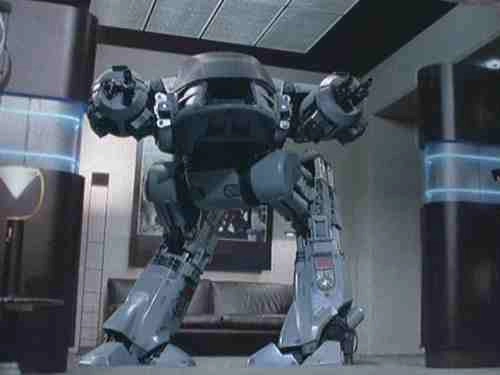
OCP! OCP! OCP!
RoboCop is such a fine film from beginning to end that it seems wrong to highlight only one little detail. However, in addition to its fantastically underrated script and its world-class cast of villainous characters, it features one of the most imposing robo-actors ever put to film. Set in an only slightly futuristic version of Detroit, Robocop is a dystopian fantasy about a fallen hero placed inside a machine.
As Officer Murphy (Peter Weller) struggles to reconcile his lingering traces of humanity with his new role as the virtually unstoppable RoboCop, he uncovers the sinister corporate underbelly of the city’s crime solution. The suits are pulling the strings, don’t you know, and a company called Omni Consumer Products is running the police. Detroit’s number one psycho crook (Kurtwood Smith in the role of his life) and OCP president Dick Jones (Ronny Cox) have the city in a stranglehold. What can just one hulking robo-man do? Well…

Today’s special is Tailored Suit stuffed with Shredded Businessman.
One of the film’s most memorable scenes is the introduction of Dick Jones and his vision of Detroit’s future. It sets up the sinister, amoral climate against which RoboCop will soon have to do battle. Jones, you see, has his own plans for a mechanized defense force which ignores the human element in every way possible. His own pet project is the massive, fully robotic Enforcement Droid (ED) series 209. It walks around like something from Star Wars, roars ferociously, and threatens armed miscreants with its dual rapid-fire cannons of death.
Unfortunately, it is really more killbot than lawbot, and the prototype demonstration gets a little messy. Human confetti – enough said. Alas… had Ronny Cox gotten himself an enforcement droid in Deliverance, things might have turned out rather differently that day on the river.
Despite its brief appearances on screen, ED-209 makes a lasting impression as one of the most fearsome robots ever imagined for a movie. Its troubling lack of precise intelligence makes it more of a savage beast than a machine, and the blurring of that line is wonderfully disturbing in the context of Verhoeven’s twisted take on modern progress.
Bishop in Aliens (dir. James Cameron, 1986)
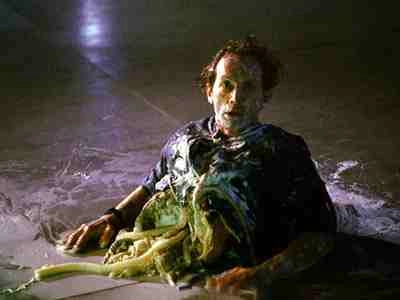
Queen Takes Bishop. What a way to go, even if it doesn’t hurt.
Bishop arrives and does his business at a more contemplative pace than most of the tougher movie robots. Nonetheless, he has a lot of depth for a character with an artificial personality. Lance Henriksen, that craggy mainstay of science fiction and horror films, walks a skillful line between eerie and comforting as the synthetic counterpart to the ultra-bad Marine force turned loose on a host of nasty, nasty bugs. What begins as a relief effort turns into a full-scale battle to get off the planet alive and un… well, all those awful things that aliens do.
Whereas the first Alien was more of a suspense thriller, James Cameron’s sequel is a high-firepower action epic. The behavior of the the robotic crewmember Ash (Ian Holm) in the former film has left Ellen Ripley (Sigourney Weaver) mighty wary of their presence, but rather sit back and pull strings, Bishop works right alongside the humans he has been programmed to guard and assist. Initially a mission officer and a skillful pilot to boot, Bishop finds himself called upon to make the ultimate sacrifice. Again, he is one of those classic Asimov robots who are incapable of allowing humans to come to harm.
In addition, he does not object to entertaining them on occasion. The character’s introductory scene involves Bill Paxton (the lovable spaz Marine of “Game over, man!” fame) inducing him to do tricks with knives for the amusement of the squad. The scene not only allows the revelation that Bishop is a robot, but also that he is not quite perfect. It also sets up the distrust Ripley harbors against synthetic people, and gives Bishop a goal – to win her confidence and respect. His interest in doing so, coupled with his minute failings on occasion, make him seem all the more human. One has to wonder whether his eventual heroism is part of his programming, or something he reasoned out for himself.
Mechagodzilla in Godzilla versus Mechagodzilla (dir. Jun Fukuda, 1974)

No fair tickling!
How do you improve on a massive kill-crazy atomic reptile? Try pitting it against a massive kill-crazy mechanized reptile, with jetpacks and lasers… from space! When alien warlords decide to invade Tokyo, they first build a robotic counterpart to destroy Godzilla, or at least frame him for their own destructive conquest.
No sir!
The Toho studio gave the original big lizard gets a shot at saving Japan, rather than stepping on it, in Godzilla versus Mechagodzilla. It seems only fair. The mythology of the kaiju (big Japanese movie monsters) is a whole other can of eggs for another and much better researched article. Suffice it to say that going robotic in the War Of The Monsters was a big step.
Fighting giant moths, sea monsters, and other quasi-dinosaurs is one thing… but robo-reptiles are a critically undertapped well of science fiction weirdness. The character even returned the following year in Terror of Mechagodzilla (one of my favorite movie titles ever, just because). The makers of film and television have made many a spoof, salute, and homage to Mechagodzilla, the greatest undoubtedly being the Mecha-Streisand episode of South Park, the second-to-last installment of the show’s first season. If you have not had the pleasure… do so.
T-1000 in Terminator 2: Judgment Day (dir. James Cameron, 1991)
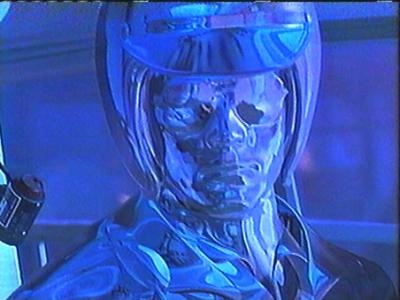
There is a problem, officer.
Despite its historic popularity and lasting influence on movie history, I have never been a huge fan of Terminator 2. Whereas the original film was a non-stop pummeling of grim science fiction, T2 spent too much time trying to make us feel sorry for two maudlin and rather hateful characters. The fact that they were humanity’s only hope did not make them any more pleasant.
To be fair, the Terminator saga has never been about strong dialogue, seamless plots or even great characters. The astounding special and visual effects in the first film, and doubly so in the second, are worth the price of admission. As we know, that was not a good lesson to teach a young moviemaker like James Cameron, but there you are. Arnold Schwarzenegger returns, not as a massive force of destruction, but as a massive force of salvation, as the robotic master race of the future has decided to send an upgraded Terminator model, the T-1000, to destroy young John Connor and his mother before they can be a threat to robot kind.

He’s walked out of better jails than this.
Robert Patrick became an overnight icon in the role of T-1000, much the same as Scharzenegger himself in the previous film. A liquid metal entity, T-1000 couples unbelievable strength with the ability to change shape, melt through anything, imitate and infiltrate people and things at will. It certainly takes a lot to survive its pursuit, and a whole lot more to defeat it.
The role allowed Robert Patrick to become a household name in sci-fi, and the Stan Winston studio to produce some of its most acclaimed and best known work. For the record, and with all respect to the law establishment, I will forever be slightly more wary of clean-cut young policemen.
JULIA’S PICKS:
Bobbie Markowe in The Stepford Wives (dir. Bryan Forbes, 1975)
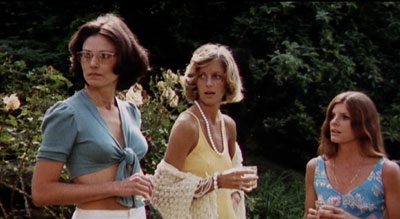
Enjoy those pants and halters while you can, ladies.
The Stepford Wives is based on a book by Ira Levin, who also wrote Rosemary’s Baby and its little-known sequel. Levin’s work is frightening, feminist, and was at the time really progressive. His female protagonists devolve into hysteria as the world around them closes in (Roman Polanski, who made Rosemary’s Baby in 1968, loved this topic–he also experimented with female sexual guilt/neurosis in Repulsion). In both of Levin’s novels (and their respective movies), the characters’ panicked paranoia is beyond merited.

Women aren’t supposed to recline. Or wear anything but ruffles and derby hats. Didn’t you know?
In The Stepford Wives, Joanna Eberhart (Katharine Ross) moves from NYC to Stepford, in upstate New York, with her family. Her displacement is obvious and uncomfortable – her photography takes a back burner in Stepford to her role as housewife. Meanwhile, her husband Walter (Peter Masterson) joins the creepy, cultish Men’s Association. Joanna finds in Bobbie Markowe (Paula Prentiss) a kindred spirit – enthusiasm, curiosity, annoyance with–and eventually fear of–Stepford’s submissive housewives. Bobbie’s a jeans-clad, halter-topped happy mess, her house cluttered and her cooking flawed. She’s thrilled to start a Women’s Consciousness Raising group in Stepford…if only Stepford’s housewives would have a thing to do with it.
Just as Joanna and Bobbie begin to investigate what’s in the water in Stepford, and as Walter becomes more distraught, Bobbie suddenly makes a drastic transformation.
And perfection is seriously spooky. (Apologies for the flawed embed.)
The gentlemen of Stepford, led by former Disney animatronics specialist Diz, strive to hold on to the “good old days” when wives had dinner on the table promptly at 6:00, mothered the children with utmost love and care, kept the house impeccable, doted on their hardworking spouses. And why not add in bigger boobs, prettier faces, and more feminine dress while we’re at it? The women’s movement soldiered on–but not in Stepford.
Six in “Battlestar Galactica” (multiple directors, 2004-2009)

Six (Tricia Helfer), Three (Lucy Lawless), and Eight (Grace Park): Just as in fictional 1975, in the future humans sure know how to make ’em pretty.
Confession time: I haven’t seen all of “Battlestar Galactica” yet. Friends, roommates, and everyone else in the whole world have been telling me for years that I’d love it, but people said the same thing about “Buffy” and the Harry Potter series. I didn’t see/read those until well after the hype had mostly died down. Stubbornness and self-awareness do not an up-to-date critic make.
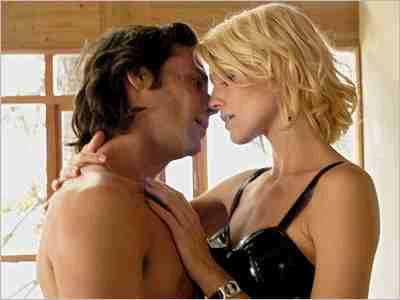
Six and Gaius – creeps, both of them.
Six (Tricia Helfer) is one of the series’ constants – there are twelve Cylon models, but she (it) is the most prominent. She’s a femme-fatale-bot through and through, but her missions become problematic when she gets feelings for devious creep Gaius Baltar (James Callis). For her work, seducing humans and killing them almost equally, the other cylons practically worship at her feet. She’s a mother figure, a lover, a murderer, a spurned prophet. She’s not human, but along with a few other Cylon models, she helps us realize their technology hasn’t created a bunch of emotionless androids; far from it.
Too sexy?
I told a friend during the first season, “Tricia Helfer looks too…alien…to even be attractive.” This is true when she looks most like a robot–adorned with bandage-trussed carmine dresses, with platinum curls and flawless skin. However, in her many other incarnations, her hair is darker, her makeup and facial expressions more humanoid. Six’s role is duly interesting because of her constant presence in Baltar’s warped mind, and his in hers. The two of them share a mental connection based on what might’ve been real love or just selfishness on both their parts–and it’s beautifully edited, filmed, and written. She’s one of television’s best robots.
WALL-E and EVE in WALL-E (dir. Andrew Stanton, 2008)
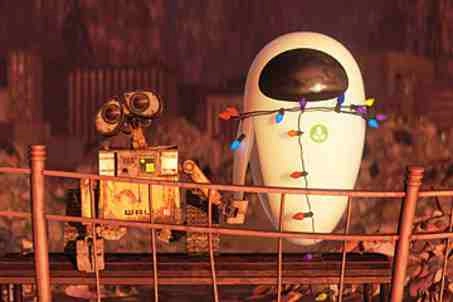
Who says robots are cold and heartless? Not us here at The Fourth Wall.
I still maintain that anyone who doesn’t like WALL-E doesn’t have a heart. With minimal dialogue, beautiful animation, and adorable characters, Andrew Stanton and the Pixar crew developed a movie it’s just plain hard not to fall in love with.
Waste Allocation Load Lifter – Earth Class (WALL-E) is an outdated, lonely little robot left on earth to clean up after humans’ mess. His only friend is a cockroach–until Extraterrestrial Vegetation Evaluator (EVE) is dispatched to the dead planet to see if it’s habitable again. WALL-E and EVE strike up a friendship that takes on traits of WALL-E’s beloved old romantic musicals – one of the only entertainments offered to him on earth. The two sail around space in a choreographed dance; WALL-E protects the immobilized EVE from earth’s deadly dust-storms; EVE helps WALL-E save the only surviving plant on earth.
I mean, if you can watch this and not smile, you’re a heartless cur.
Humans, having demolished our home planet and sailed away into space to grow fat, sedentary, and complacent, are under the control of AUTO, the autopilot on their ship. It’s all…entirely too plausible, but not preachy. Stanton and crew could have made the humans villainous; after all, they’ve succeeded in destroying the earth. Fortunately for everyone, though, when given a wake-up call, WALL-E‘s humans prove themselves quite capable of change and eager to help their robot friends. Instead the villain is another robot, AUTO, whose programming simply doesn’t allow him to deviate from the scheduled course.

Auto, Captain, and EVE: an odd threesome.
I listed WALL-E as one of the best films of the last decade, and I’ll stand by it. We’re entirely too close to ruining the earth, and assuming our technology continues to develop at the same rates, the plot of the movie isn’t so farfetched. It’s a gorgeously rendered, intelligent, playful, and sweet flick about what we’re in for. If it involves WALL-E and EVE being my best friends, I’m so there.
MATT’S PICKS:
Maria in Metropolis (dir. Fritz Lang, 1922)
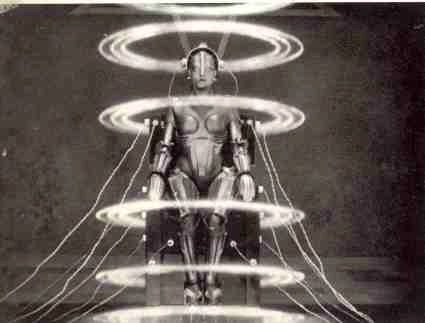
It’s…ALIVE!!!
Arguably the first masterpiece of science fiction cinema, Fritz Lang’s Metropolis provides us with one of the earliest glimpses of robots on film, and the first interpretation of what we still think of as a robot or android figure. In the film, Maria is a leader for the workers laboring underground, preaching cooperative negotiations with the oppressive leaders above in the city. She is also the love interest of the man who could be called the film’s hero, Freder, who becomes entangled in the workers’ rights movement when he ventures into the underground city and sees the horrible conditions the citizens and workers live in and seeks to have his father, Joh Fredersen, treat them better.
The robot comes into play via a nefarious plot by Fredersen and the evil scientist (this movie really does have everything) Rotwang in which they seek to lead the workers to outright revolt and thus bring their iron fist down even harder upon them to quell any sort of feelings toward equality or better conditions. Rotwang creates a robot to replace Maria, and then to do his bidding.
The first glimpse of the robot, a shiny, metal androgynous figure is now a classic figure, probably horrible at the time when it gets up from its throne and begins moving (let’s not forget that Metropolis also fits the mold of Expressionist horror as well), and then suddenly transforms into the human visage of Maria. This scene, in which our monster comes roaring to life, is one of the most influential in all of cinema history, echoed most notably in the Universal horror films which relied heavily on Lang’s cinematographer and future innovator of both film and television photography here in the United States, Karl Freund.
Since its release, Metropolis has been edited and re-edited, from an initial running time of over 2 1/2 hours to just over 90 minutes (and under in some later versions), so that recent discoveries and additions to the film in an effort to restore it closer to Lang’s original cut have just now begun to give modern audiences a more rounded viewing experience. Still, the film remains highly influential and is even thrilling to experience today, no matter how pacing has changed over the last hundred years. And the most memorable things in Metropolis are still its scenes of dystopian futures that may yet come to pass, and the robot Maria, coming to life in a halo of electricity and movie magic.
The Iron Giant in The Iron Giant (dir. Brad Bird, 1999)
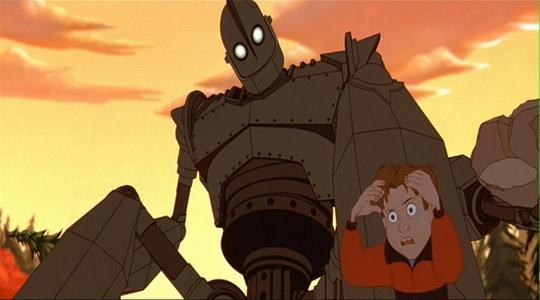
An imposing figure.
Brad Bird’s 1999 film The Iron Giant was hailed as an instant classic upon its release, and though time has only built that esteem for its fans, I fear it has dropped off the radar of the general public for the time being. The film is quite simple, chronicling the friendship between a small boy, Hogarth Hughes, and a giant alien robot that lands in his yard. The plot gets going with the introduction of a government agent who thinks the alien must be destroyed before he can harm anyone on Earth.
The giant is typical of the skeletal robotic type, with a lanky awkwardness that is meant to mimic the internal skeleton of a human, and even bears the threat of overtaking humanity altogether in android form. Of course, this being a children’s film, there is no real threat of that happening, and his human qualities actually lead to the life lessons a film like this sets out to teach its young viewers: friendship, equality and trust.
The Iron Giant is one of my absolute favorite films, animated or otherwise. I love the giant make-up of the robot’s design that recalls the evil robots from early Fleischer Superman cartoons, and I love that the animation is allowed to look like it’s animated, completely disregarding a true form of realism. Hogarth has large ears and an exaggerated gap in his teeth, and it really works for the type of fantastic film Bird is telling.
One of my favorite films of all time, The Iron Giant is a touching, sweet film that’s appropriate for very young children, but which fans of animation of all ages find dazzling. It’s a marvel of storytelling and character design, and it deserves more attention than it gets from the casual movie fan.
Robby the Robot in Forbidden Planet (dir. Fred M. Wilcox, 1956)
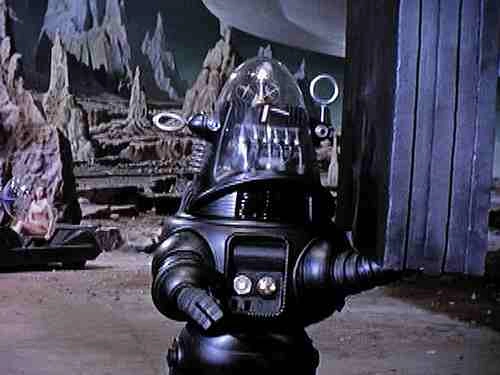
THE robot…
Here’s a robot so popular that he was actually stolen and used repeatedly in other projects for well over twenty years, making appearances with slight modifications in projects ranging from authorized B-movie sequels (the 1957 film The Invisible Boy) to television shows like Lost In Space and even Charmin toilet paper commercials that feature Robby squeezing the Charmin much to Mr. Whipple’s chagrin. To this day you can still buy kits and build your very own Robby, not to mention the prominence of his figure on children’s lunchboxes, shirt illustrations, and much much more.
The plot of Forbidden Planet is somewhat fairly standard for today’s audiences, concerning a ship sent to the planet Altair IV to discover the fate of a colony established there 20 years earlier. They receive a warning to stay away, but they land and are met by Robby the Robot and taken to Morbius, a doctor studying the native species of the planet who died out under mysterious circumstances millennia before, and who has discovered a great machine within the planet that can create anything that can be imagined. There’s a monster that’s wiped out the colony, and, oh yeah, it’s a monster from the Id; Morbius’s Id to be precise. The crew eventually leave the planet with Morbius’ daughter in tow as Morbius stays behind to make sure the machine is destroyed.
Ludicrous as that all sounds, the film is quite engrossing, and I find particular pleasure in the blossoming romance between Leslie Nielsen’s Commander John Adams and Anne Francis’ Altaira that leads to a lot of the film’s dramatic conflict. And Robby is the quintessential robot. He may not be humanoid, but he is a complete construction that looks and behaves like a computer might if given some form of real artificial intelligence.
I find it more than a bit odd that Robby was so popular for so long, but is probably largely forgotten by post-80s generations, who all grew up with very different interpretations of robotics and the nature of their subservient relationship with man. Maybe this design will come to prominence again, but something tells me with the many advances in real world robotics just in the past decade Robby may soon be a total product of a by-gone era, a romantic dalliance that didn’t quite come out as imagined, and completely unrecognizable in pop culture as the icon that he was before.





1 Comment
You must be logged in to post a comment Login